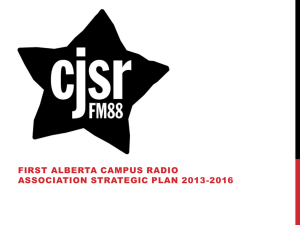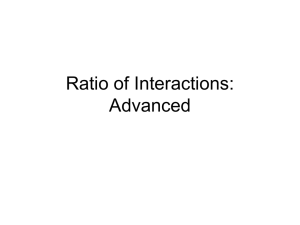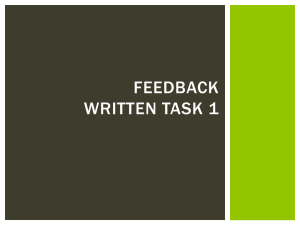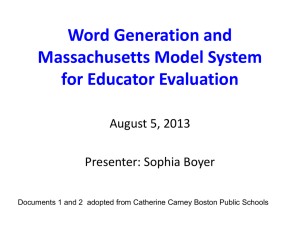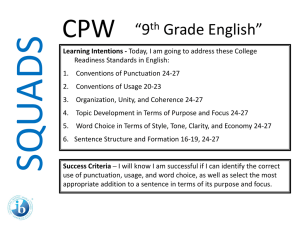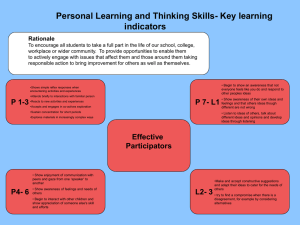Chapter 33: Geriatric Emergencies
advertisement
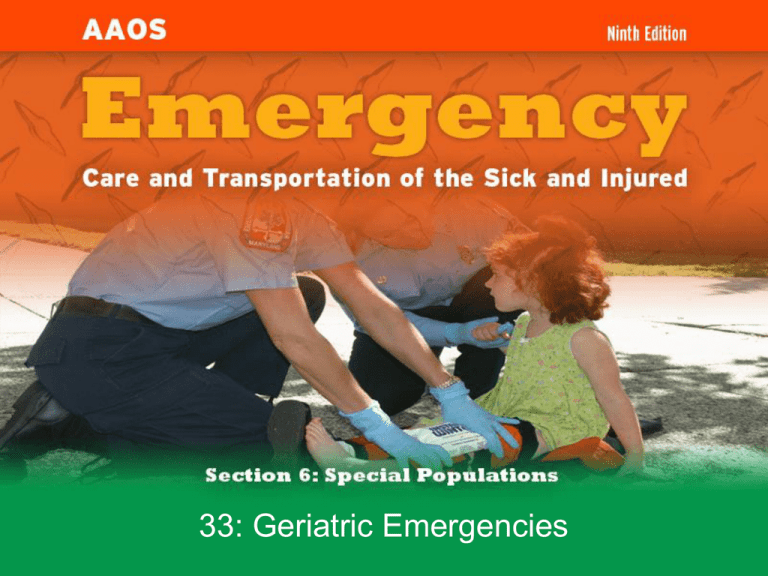
33: Geriatric Emergencies Cognitive Objectives (1 of 2) 1. Define the term “geriatric.” 2. Discuss appropriate ways to communicate with geriatric patients. 3. Discuss the GEMS diamond. 4. State the leading causes of death of the geriatric population. 5. Describe the physiologic changes of aging. Cognitive Objectives (2 of 2) 6. Define the problem known as polypharmacy. 7. State the principles and use of advance directives involving older patients. 8. Define elder abuse. 9. Discuss the causes of elder abuse. 10. Discuss why the extent of elder abuse is not well known. Affective Objectives 11. Explain why the special needs of older people and the changes that the aging process brings about in physical structure, body composition, and organ function provide a fundamental base for maintenance of life support functions. • • There are no psychomotor objectives for this chapter. All of the objectives in this chapter are noncurriculum objectives. Geriatrics (1 of 2) • Geriatric patients are individuals older than 65 years of age. • In 2000, the geriatric population was almost 35 million. • By 2020, the geriatric population is projected to be greater than 54 million. Geriatrics (2 of 2) • Older people are major users of EMS and health care in general. • Effective treatment will require an increased understanding of geriatric care issues. Communications (1 of 2) • Show the patient respect. • Position yourself at eye level in front of the patient. • Speak slowly and distinctly. • Give the patient time to answer. • Be patient. Communications (2 of 2) Older patients may need a little more time to process your question. The GEMS Diamond • Geriatric patients: Normal aging, atypical presentation • Environmental assessment: Safety, neglect • Medical assessment: Past history, medications • Social assessment: Basic needs, social network Leading Causes of Death • • • • • • Heart disease Cancer Stroke COPD and other respiratory illnesses Diabetes Trauma Common Stereotypes • Common stereotypes include mental confusion, illness, sedentary lifestyle, and immobility • Older people can stay fit; most older people lead very active lives. Physiologic Changes (1 of 3) • Skin – Susceptible to injury; longer healing time • Senses – Dulling of the senses • Respiratory system – Decreased ability to exchange gases Physiologic Changes (2 of 3) • Cardiovascular system – Increased risk of cardiovascular disease • Renal system – Decline in kidney function • Nervous system – Memory impairment, decreased psychomotor skills Physiologic Changes (3 of 3) • Musculoskeletal system – Decrease in muscle mass and strength • Gastrointestinal system – Decrease in ability of body to digest food properly Polypharmacy • Older people account for a large portion of overall medication usage. • Many medications can have interactions or counter actions when taken together. • Polypharmacy refers to the use of multiple prescriptions by a single patient. Geriatrics and Trauma • An older patient may have decreased ability to localize even simple injuries. • Assessment must include all past medical conditions. Cardiovascular Emergencies • Syncope – Interruption of blood flow to the brain – Many underlying causes • Heart attack – Classic symptoms often not present Acute Abdomen (1 of 3) • Acute abdominal aneurysm – Walls of the aorta weaken. – Treat for shock and provide prompt transport. • Gastrointestinal bleeding – Blood in emesis – May cause shock Acute Abdomen (2 of 3) • Bowel obstructions – Vagus nerve is stimulated and produces vasovagal syndrome. – Vasovagal syndrome can cause dizziness and fainting. – Patient requires transport to rule out other conditions. Acute Abdomen (3 of 3) Older patients with abdominal pain have higher chances of hospitalization, surgery, and death than younger patients. Altered Mental Status • Delirium – Recent onset – Usually associated with underlying cause • Dementia – Develops slowly over a period of years Psychiatric Emergencies (1 of 2) • Depression is common among older adults. • Physical pain, psychological distress, and loss of loved ones can lead to depression. • Women are more likely to suffer depression. Psychiatric Emergencies (2 of 2) • Older men have the highest suicide rate. • Older patients use much more lethal means. • EMT-Bs should consider all suicidal thoughts or actions to be serious. Advance Directives • Do not resuscitate (DNR) orders give you permission not to attempt to resuscitate. • DNR orders may only be valid in the health care facility. • You should know state and local protocols regarding advance directives. • When in doubt, initiate resuscitation. Elder Abuse (1 of 2) • This problem is largely hidden from society. • Definitions of abuse and neglect among older people vary. • Victims are often hesitant to report an incident. • Signs of abuse are often overlooked. Elder Abuse (2 of 2) Nursing home residents who receive no visitors have a higher likelihood of abuse and neglect. Assessment of Elder Abuse (1 of 2) • Repeated visits to the emergency room • A history of being “accident prone” • Soft-tissue injuries • Vague explanation of injuries • Psychosomatic complaints Assessment of Elder Abuse (2 of 2) • Chronic pain • Self-destructive behavior • Eating and sleeping disorders • Depression or a lack of energy • Substance and/or sexual abuse Signs of Physical Abuse • Signs of abuse may be obvious or subtle. • Obvious signs include bruises, bites, and burns. • Look for injuries to the ears. • Consider injuries to the genitals or rectum with no reported trauma as evidence of abuse. Review 1. A condition that clouds the lens of the eye is called: A. cataract. B. nystagmus. B. astigmatism. D. glaucoma. Review Answer: A Rationale: As people get older, cataracts, or clouding of the lens of the eye, may interfere with vision. Glaucoma is a condition caused by increased intraocular pressure (IOP). Nystagmus is characterized by involuntary movement of the eyes. Astigmatism is an optical defect that causes blurred vision due to the inability of the eye to focus an object into a sharp, focused image on the retina. Review 1. A condition that clouds the lens of the eye is called: A. cataract. Rationale: Correct answer B. nystagmus. Rationale: This is a horizontal, involuntary movement of the eyes. B. astigmatism. Rationale: This is an optical defect that causes blurred vision. D. glaucoma. Rationale: This is a condition caused by increased intraocular pressure (IOP). Review 2. The LEAST common cause of death in patients over 65 years of age is: A. stroke. B. diabetes. C. heart attack. D. drug overdose. Review Answer: D Rationale: The leading causes of death in patients over 65 years of age are heart disease, diabetes, stroke, cancer, pulmonary diseases, and trauma. Drug overdose—intentional or unintentional—is not a leading cause of death in this age group. Review 2. The LEAST common cause of death in patients over 65 years of age is: A. stroke. Rationale: This is one of the common causes of death. B. diabetes. Rationale: This is one of the common causes of death. C. heart attack. Rationale: This is one of the common causes of death. D. drug overdose. Rationale: Correct answer Review 3. Polypharmacy is a term used to describe a patient who takes: A. multiple medications. B. other peoples medication. C. a medication more than once a day. D. medication only when they feel they need to. Review Answer: A Rationale: Polypharmacy is a term used to describe a patient who takes multiple medications every day. The more medications a patient takes, the greater the risk of a negative drug interaction. Review 3. Polypharmacy is a term used to describe a patient who takes: A. multiple medications. Rationale: Correct answer B. other people’s medication. Rationale: This is incorrect. C. a medication more than once a day. Rationale: Many medications are taken more than once a day. D. medication only when they feel they need to. Rationale: This is considered noncompliant. Review 4. The slow onset of progressive disorientation, shortened attention span, and loss of cognitive function is called: A. senility. B. delirium. C. dementia. D. delusion. Review Answer: C Rationale: Dementia is defined as the slow onset of progressive disorientation, shortened attention span, and loss of cognitive function. Alzheimer’s disease is an example of dementia. In contrast to dementia, delirium is an acutely altered mental status, such as that caused by hypoglycemia. Review 4. The slow onset of progressive disorientation, shortened attention span, and loss of cognitive function is called: A. senility. Rationale: Senility causes forgetfulness and confusion. The person is mentally less acute in later life. B. delirium. Rationale: Delirium is an acutely altered mental status. C. dementia. Rationale: Correct answer D. delusion. Rationale: Delusion is a fixed belief that is not shared by others and cannot be changed by reasonable argument. Review 5. Which of the following conditions makes the elderly patient prone to fractures from even minor trauma? A. Hypertension B. Osteoporosis C. Arteriosclerosis D. Rheumatoid arthritis Review Answer: B Rationale: Osteoporosis, a decrease in bone density that causes the bones to become brittle, makes elderly patients prone to fractures, even from minor trauma. It is especially common in postmenopausal women. Review 5. Which of the following conditions makes the elderly patient prone to fractures from even minor trauma? A. Hypertension Rationale: This is high blood pressure. B. Osteoporosis Rationale: Correct answer C. Arteriosclerosis Rationale: This is the stiffening or hardening of the arteries. D. Rheumatoid arthritis Rationale: This is an inflammatory disorder that affects the entire body and leads to degeneration and deformation of joints. Review 6. A 71-year-old man with a history of hypertension and vascular disease presents with tearing abdominal pain. His blood pressure is 80/60 mm Hg, his heart rate is 120 beats/min, and his respirations are 28 breaths/min. Your assessment reveals that his abdomen is rigid and distended. Considering his medical history and vital signs, you should be MOST suspicious for a/an: A. aortic aneurysm. B. hemorrhagic stroke. C. acute myocardial infarction. D. infarction of the large intestine. Review Answer: A Rationale: Arteriosclerosis is a vascular disease in which the arteries thicken, harden, and calcify. This places the patient at risk for stroke, heart disease, bowel infarction, and hypertension, among other conditions. Hypertension and vascular disease are significant risk factors for an aneurysm—a weakening in the wall of an artery. The patient’s vital signs; abdominal pain; and rigid, distended abdomen should make you highly suspicious for a leaking abdominal aortic aneurysm. Review (1 of 2) 6. A 71-year-old man with a history of hypertension and vascular disease presents with tearing abdominal pain. His blood pressure is 80/60 mm Hg, his heart rate is 120 beats/min, and his respirations are 28 breaths/min. Your assessment reveals that his abdomen is rigid and distended. Considering his medical history and vital signs, you should be MOST suspicious for a/an: A. aortic aneurysm. Rationale: Correct answer B. hemorrhagic stroke. Rationale: This is when the patient complains of the worst headache of his life, loses the ability to speak, and eventually becomes difficult to arouse. It tends to worsen over time. Review (2 of 2) 6. A 71-year-old man with a history of hypertension and vascular disease presents with tearing abdominal pain. His blood pressure is 80/60 mm Hg, his heart rate is 120 beats/min, and his respirations are 28 breaths/min. Your assessment reveals that his abdomen is rigid and distended. Considering his medical history and vital signs, you should be MOST suspicious for a/an: C. acute myocardial infarction. Rationale: Although the patient history could predispose him to an acute MI, the symptoms would be pain in the chest or shoulder, nausea, vomiting, a feeling of shortness of breath, and sweating. D. infarction of the large intestine. Rationale: This is an area of the intestine that has not received blood and oxygen. If it ruptures, it would present with signs of peritonitis, which is an inflammation of the lining of the abdomen. Review 7. Inflicted bruises are commonly found in all of the following areas, EXCEPT: A. the buttocks. B. the lower back. C. the inner thighs. D. the forearms. Review Answer: D Rationale: Inflicted bruises are typically found on the buttocks and lower back, genitalia and inner thighs, cheek or earlobe, upper lip and inside the mouth, and neck. Bruises to these areas should increase your index of suspicion for abuse. Review 7. Inflicted bruises are commonly found in all of the following areas, EXCEPT: A. the buttocks. Rationale: These are typically inflected bruises. B. the lower back. Rationale: These are typically inflected bruises. C. the inner thighs. Rationale: These are typically inflected bruises. D. the forearms. Rationale: Correct answer Review 8. Which of the following is a physiologic change that occurs during the process of aging? A. Increased elasticity of the alveoli. B. A gradual decrease in blood pressure C. 20% to 50% decline in kidney function D. 10% to 15% increase in brain weight Review Answer: C Rationale: As a person gets older, certain anatomic and physiologic changes occur. The alveoli in the lungs become less elastic, even though their overall size increases. Blood pressure gradually increases secondary to the process of arteriosclerosis (hardening of the arteries). A 20% to 50% decline in kidney function occurs because of a decrease in the number of nephrons (the basic structural and functional unit of the kidney). By the age of 85 years, a 10% reduction in brain weight occurs, which causes an increased risk of head trauma. Review 8. Which of the following is a physiologic change that occurs during the process of aging? A. Increased elasticity of the alveoli. Rationale: With aging, alveoli lose some of their elasticity. B. A gradual decrease in blood pressure Rationale: Blood pressure generally increases due to arteriosclerosis. C. 20% to 50% decline in kidney function Rationale: Correct answer D. 10% to 15% increase in brain weight Rationale: The brain decreases in weight by 5 to 10%. Review 9. According to the GEMS diamond, a person’s activities of daily living are evaluated during the: A. SAMPLE history. B. social assessment. C. medical assessment. D. environmental assessment. Review Answer: B Rationale: The GEMS diamond was created to help you remember what is unique to older people. During the social assessment (the “S” in the GEMS diamond), the patient’s activities of daily living (eg, eating, dressing, bathing, toileting) are evaluated. Are these activities being provided? If so, by whom? Are there delays in obtaining food, medication, or other necessary items? Review 9. According to the GEMS diamond, a person’s activities of daily living are evaluated during the: A. SAMPLE history. Rationale: This is a mnemonic used when obtaining information during a focused history and physical exam. B. social assessment. Rationale: Correct answer C. medical assessment. Rationale: “M” is obtained by a thorough medical history. It is important and is completed before the social assessment. D. environmental assessment. Rationale: “E” is the assessment of the environment. It considers if the home is well kept, too hot or too cold, or any hazards. Review 10. You are called to a neatly kept residence for an 80year-old woman who lives by herself. She burned her hand on the stove and experienced a full-thickness burn. When treating this patient, it is important to note that: A. there is a high likelihood that she has been abused. B. isolated full-thickness burns to the hand are not critical burns. C. this patient should probably be placed in an assistedliving center. D. slowing of reflexes causes a delayed pain reaction in older people. Review Answer: D Rationale: In older patients, the sense of touch decreases due to a loss of the end-nerve fibers. This loss, in conjunction with slowing of the peripheral nervous system, causes a delayed reaction to pain. In this particular scenario, there is no indication that the patient has been abused. Partial- and full-thickness burns to the hands, feet, face, and genitalia are considered critical burns— regardless of the patient’s age. Review (1 of 2) 10. You are called to a neatly kept residence for an 80-year-old woman who lives by herself. She burned her hand on the stove and experienced a full-thickness burn. When treating this patient, it is important to note that: A. there is a high likelihood that she has been abused. Rationale: There is no indication of abuse in this situation. B. isolated full-thickness burns to the hand are not critical burns. Rationale: Any full-thickness burns of the hands, face, feet, or genitalia are considered critical. Review (2 of 2) 10. You are called to a neatly kept residence for an 80-year-old woman who lives by herself. She burned her hand on the stove and experienced a full-thickness burn. When treating this patient, it is important to note that: C. this patient should probably be placed in an assisted-living center. Rationale: This is not an indication that the patient cannot take care of herself. D. slowing of reflexes causes a delayed pain reaction in older people. Rationale: Correct answer
